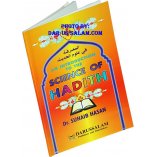




 Read the review
Read the review
| Subtitle | المعرفة في علم الحديث |
| Author | Suhaib Hasan |
| Binding | Paperback |
| Pages | 64 |
| Size in Inches | 5.5x8 |
| Size in CM | 14x20 |
| Edition | 1st (November 1999) |
| Weight (lbs) | 0.25 |
The Muslims in general believe that the Qur'an has been preserved intact and pure by Allah Himself. But what is often forgotten by many is that this preservation necessarily includes the Sunnah of the Prophet Muhammad (S), the practical example of the implementation of the Qur'an.
Hadith is Sunnah in record. How the immense wealth of Hadith literature has been left to us by the Muhaddiths (scholars of Hadith) is an extremely wide, complex study.
We publish this short treatise on "the science of Hadith" by the learned Suhaib Hasan with English readers in mind. It is part of our scheme to introduce various aspects of Islam to English readers. May Allah accept it as a good work.
All Praise be to Allah, Lord of the Worlds. Peace and blessings of Allah be upon our Prophet Muhammad, and on his family and companions.
We have undoubtedly sent down the Reminder, and We will truly preserve it. (Al-Qur'an, Surah al-Hijr, 15:9)
The above promise made by Allah is obviously fulfilled in the undisputed purity of the Qur'anic text throughout the fourteen centuries since its revelation. However, what is often forgotten by many Muslims is that the above divine promise also includes, by necessity, the Sunnah of the Prophet Muhammad (S) for it is the practical example of the implementation of the Qur'anic guidance, the Wisdom taught to the Prophet (S) along with Scripture, and neither the Qur'an nor the Sunnah can be understood correctly without recourse to the other.
Hence, Allah preserved the Qur'an from being initially lost by the martyrdom of its memorizers, by guiding the Rightly-Guided Caliphs, endorsed by the consensus of the Messenger's Companions (R) to compile the ayat (signs, miracles, "Verses") of the Qur'an into one volume, after these had been scattered in writing on various materials and in memory amongst many faithful hearts. He safeguarded it from corruption by its enemies: disbelievers, heretics, and false prophets, by enabling millions of believers to commit it to memory with ease. He protected its teachings by causing thousands of people of knowledge to learn from its deep treasures and convey them to the masses, and by sending revivers of His Deen at the beginning of every century.
Similarly, Allah preserved the Sunnah by enabling the Companions and those after them (R) to memorize, write down and pass on the statements of the Messenger (S) and the descriptions of his Way, as well as to continue the blessings of practicing the Sunnah. Later, as the purity of the knowledge of the Sunnah became threatened, Allah caused the Muslim nation to produce outstanding individuals of incredible memory-skills and analytical expertise, who journeyed tirelessly to collect hundreds of thousands of narrations and distinguish the true words of precious wisdom of their Messenger (S), from those corrupted by weak memories, from forgeries by unscrupulous liars, and from the statements of the enormous number of 'ulama', the Companions and those who followed their way, who had taught in various centers of learning and helped to transmit the legacy of Muhammad (S) - all of this achieved through precise attention to the words narrated and detailed familiarity with the biographies of the thousands of reporters of Hadith. Action being the best way to preserve teachings, the revivers of Islam also revived the practice of the blessed authentic Sunnah. (continued on page 8)
The Muslims are agreed that the Sunnah of the Prophet Muhammad (S) is the second of the two revealed fundamental sources of Islam, after the Glorious Qur'an. The authentic Sunnah is contained within the vast body of Hadith literature.
A hadith (pl. ahadith) is composed of two parts: the matn (text) and the isnad (chain of reporters). A text may seem to be logical and reasonable but it needs an authentic isnad with reliable reporters to be acceptable; 'Abdullah bin Al-Mubarak (d. 181 AH), one of the illustrious teachers of Imam al-Bukhari, said:
“The isnad is part of the religion: had it not been for the isnad, whoever wished to would have said whatever he liked.”
During the lifetime of the Prophet (S) and after his death, his Companions (Sahabah) used to refer to him directly, when quoting his saying. The Successors (Tabi'un) followed suit; some of them used to quote the Prophet (S) through the Companions while others would omit the intermediate authority - such a hadith was .later known as mursal. It was found that the missing link between the Successor and the Prophet (S) might be one person, i.e. a Companion, or two people, the extra person being an older Successor who heard the hadith from the Companion. This is an example of how the need for the verification of each isnad arose. Imam Malik (d. 179) said, "The first one to utilize the isnad was Ibn Shihab al Zuhri" (d. 124). The other more important reason was the deliberate fabrication of ahadith by various sects which appeared amongst the Muslims, in order to support their views (see later, under discussion of maudu' ahadith). Ibn Sirin (d. 110), a Successor, said, "They would not ask about the isnad: But when the fitnah (trouble, turmoil, esp. civil war) happened, they said: Name to us your men. So the narrations of the Ahl al¬Sunnah (Adherents to the Sunnah) would be accepted, while those of the Ahl al-Bid 'ah (Adherents to Innovation) would not be accepted. "
